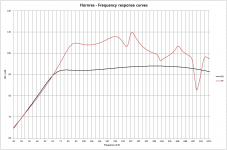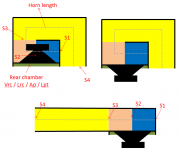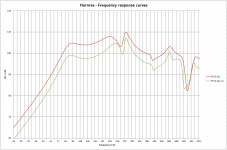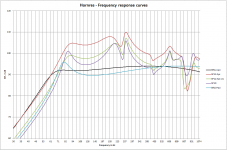Yes, there we go, that works
Johannes is experimenting with a Paraflex layout  His driver is the Alpine SWR8 D2 ..
His driver is the Alpine SWR8 D2 ..
Paraflex loaded with Alpine SWR 8
Paraflex loaded with Alpine SWR 8
Hello MMJ,
I'm thinking about to replace one 10" bass reflex in near future for an 12", I'm open to try a different design.
Do you think would be possible to achieve the targets below with super planar tops?
single driver 12"
frequency bandwidth: from 100Hz to 1000Hz
SPL: >100dB @2,83V@1m
Volume: < 150L
I'm thinking about to replace one 10" bass reflex in near future for an 12", I'm open to try a different design.
Do you think would be possible to achieve the targets below with super planar tops?
single driver 12"
frequency bandwidth: from 100Hz to 1000Hz
SPL: >100dB @2,83V@1m
Volume: < 150L
Yes
Sansui ,
Good news! We can do better than that using a single PA 12" in a Super Planar top such as: 100 liter net (or a bit less) , bottom end will be solid to around 80hz
We can do better than that using a single PA 12" in a Super Planar top such as: 100 liter net (or a bit less) , bottom end will be solid to around 80hz  and sensitivity would exceed 100db @1w/1m (at least in the midbass range) in Halfspace (as high as 104db @1w/1m at 90hz+) ... Response will have a gentle downward sloping "House Curve" above it's midbass hump and will reach all the way up to 1000hz ....
and sensitivity would exceed 100db @1w/1m (at least in the midbass range) in Halfspace (as high as 104db @1w/1m at 90hz+) ... Response will have a gentle downward sloping "House Curve" above it's midbass hump and will reach all the way up to 1000hz ....
Sansui ,
Good news!
 We can do better than that using a single PA 12" in a Super Planar top such as: 100 liter net (or a bit less) , bottom end will be solid to around 80hz
We can do better than that using a single PA 12" in a Super Planar top such as: 100 liter net (or a bit less) , bottom end will be solid to around 80hz MMJ, thanks for the good news.
For a top cab, free space (4pi) wouldn't be more realistic?
Could you try a first simulation with the parameter below?
Driver model: HPX2120
fs = 65Hz
Re = 5 ohm
Qms = 9,571
Qes = 0,235
Qts = 0,230
Vas = 41,93 L
Sd = 0,053 m^2
Xmax = 5,7mm
Le = 0,54 mH
BL = 18,98 T/m
no = 5%
mms = 55,2g
Regarding directivity, how equal or different do you think the super planar top is compared to BR?
For a top cab, free space (4pi) wouldn't be more realistic?
Could you try a first simulation with the parameter below?
Driver model: HPX2120
fs = 65Hz
Re = 5 ohm
Qms = 9,571
Qes = 0,235
Qts = 0,230
Vas = 41,93 L
Sd = 0,053 m^2
Xmax = 5,7mm
Le = 0,54 mH
BL = 18,98 T/m
no = 5%
mms = 55,2g
Regarding directivity, how equal or different do you think the super planar top is compared to BR?
Sansui ,
Your HPX2120 models well in a simple 1x12 Super Planar top ... This one is 85 liters net with a 90cm long main path with constant 600cm2 Cross Sectional Area ..... The high-tuned resonator (in this case our front chamber but Hornresp sees it as the "rear vented" chamber in the model) has 1000cm2 CSA and is 30cm long/deep ..
NOTE: The path could be made longer if you gave it some expansion, output and efficiency would increase but so would the cabinet volume ..
Below is the code copied from the export file (constant CSA , simple Super Planar top):
If the cabinet was made mildly trapezoidal shaped then i think these would be great used in multiples placed side-by-side "splayed" as part of a stack style PA system
Your HPX2120 models well in a simple 1x12 Super Planar top ... This one is 85 liters net with a 90cm long main path with constant 600cm2 Cross Sectional Area ..... The high-tuned resonator (in this case our front chamber but Hornresp sees it as the "rear vented" chamber in the model) has 1000cm2 CSA and is 30cm long/deep ..
NOTE: The path could be made longer if you gave it some expansion, output and efficiency would increase but so would the cabinet volume ..
Below is the code copied from the export file (constant CSA , simple Super Planar top):
Code:
ID=42.00
Ang=2.0 x Pi
Eg=60.00
Rg=0.00
Fta=0.00
S1=600.00
S2=600.00
Con=18.80
F12=0.00
S2=600.00
S3=600.00
Con=25.90
F23=0.00
S3=600.00
S4=600.00
Con=21.50
F34=0.00
S4=600.00
S5=600.00
Con=24.30
F45=0.00
Sd=530.00
Bl=22.27
Cms=1.05E-04
Rms=2.44
Mmd=50.10
Le=0.54
Re=5.00
OD=1
Vrc=1.00
Lrc=1.00
Ap=1000.00
Lpt=30.00
Vtc=0.00
Atc=0.00
Pmax=700
Xmax=8.0
Path=0.0
Mass=0.00
Fr1=0.00
Fr2=0.00
Fr3=0.00
Fr4=0.00
Tal1=100
Tal2=100
Tal3=100
Tal4=100
Comment=Alto Falante SNAKE HPX 2120 12" Super Planar kicktops 70hz Xmax=5.7mm Sansui
~~~~~~~~~~~~~~~~~~~~~~~~~~~~~~~~~~~~~~~~~~~~~~~~~~~~~~~~~~~~~~~~~~~~~~~~~~~~~~~~~~~~
FILTER
0 0.01 0.0 -1 0 0.01 0.0 -1 0 0.01 0.0 -1
0 0.01 0.0 -1 0 0.01 0.0 -1 0 0.01 0.0 -1
100 25 0 0
40.50.50.5
0.50.50.50.5
SSSS
1111
1111
2222
1111
111
000That is a good question ...... Respectably wide horizontal coverage (upper midrange vocal clarity etc) has been reported for the 2x12 Super Planar top with toed-in crossfiring baffle ...... However a 1x12 top will surely be a different story.. I would suspect it may be more directive than a BR but there is no verification as of yet because a single driver Super Planar top has never been built , some layouts have been drawn up though .....Regarding directivity, how equal or different do you think the super planar top is compared to BR?
If the cabinet was made mildly trapezoidal shaped then i think these would be great used in multiples placed side-by-side "splayed" as part of a stack style PA system
Attachments
110dB peak around 260Hz and 82dB dip around 870Hz, wouldn't be too much for EQ?
filling dips used to be a concern.
MMJ, do you think:
1) the sketch on the attachment #1 represents the model you simulated?
2) Probably split horn path would not be able to simulated using hornresp, right?
3) Is there a way to improve the dip around 870Hz?
4) To make the simulation more accurate we should should consider 4pi space and add Vtc to proper consider cone volume, right? see a comparison at attachment #2
At attachment #3 I made a comparison with the simulations above and also comparison to a 10" version with the driver Snake ESX310 (not optimized)
filling dips used to be a concern.
MMJ, do you think:
1) the sketch on the attachment #1 represents the model you simulated?
2) Probably split horn path would not be able to simulated using hornresp, right?
3) Is there a way to improve the dip around 870Hz?
4) To make the simulation more accurate we should should consider 4pi space and add Vtc to proper consider cone volume, right? see a comparison at attachment #2
At attachment #3 I made a comparison with the simulations above and also comparison to a 10" version with the driver Snake ESX310 (not optimized)
Attachments
did you use 2 drivers in your sim?
Only 1, as indicated in the sketch
MMJ, do you think:
1) the sketch on the attachment #1 represents the model you simulated?
Sansui, in order to make the sketch correct you need to make the front chamber much deeper than what we see there (our front chamber is Vrc , Lrc , Ap and Lpt in Hornresp) ... What you are showing (in green) only looks to be a few centimeters deep ... It needs to be around 30cm deep ...
NOTE: for the range that you are trying to cover you will want the driver to be forward facing like your sketch on the top left (just give it a much deeper chamber .... Lpt=30cm)
2) Probably split horn path would not be able to simulated using hornresp, right?
We can in fact simulate split-path symmetrical designs in Hornesp ... We do it all of the time .... Since the two legs of the split path are identical and parallel connected it is easy to simulate this sort of cabinet in Hornesp ...We just model it as a single main path in Hornresp , but in our sketches and builds we have split that path into two identical paths each of which have the Cross Sectional Area of the model's main path divided by 2 ....
So for example: If our main path in Hornresp has 800cm2 CSA that means each leg of our split-path symmetrical cabinet's main path will be given 400cm2 ....
3) Is there a way to improve the dip around 870Hz?
The first question we could ask would be: "Will there really be such a dip at 870hz?" ...... There might not be ...Or it may be greatly overstated in the model....... By the time we reach 870hz the output produced by front of the cone and our front chamber ( "rear vented" in Hornresp) will be dominant .. .
In the rudimentary measurements that have been taken of the 2x12 Super Planar tops so far there never seems to be any issues with dips up around 870hz ....... The front chamber on your 1x12 will be shaped differently though , basically square instead of the 2x12's more rectangular front chamber shape ....
NOTE: Hornresp may model the "Ap" & "Lpt" based front chamber as a round tube shape , someone would need to ask David to verify that ....
4) To make the simulation more accurate we should should consider 4pi space and add Vtc to proper consider cone volume, right? see a comparison at attachment #2
You can certainly add Vtc & Atc if you want to account for the volume of air contained within the cone ...... It shouldn't significantly alter the results ...
Some people may prefer to model tops in 4pi , and other folks may prefer to model in 2pi .... It can be done either way really ........ When making comparisons just remember to use the same standard for both models to be fair otherwise the comparison would be misleading ..
At attachment #3 I made a comparison with the simulations above and also comparison to a 10" version with the driver Snake ESX310 (not optimized)
Your 10" model definitely needs adjustment .. . Try reducing the main path's Cross Sectional Area to see if that helps to alleviate the nasty peak at Fb & the saddle shaped response just above Fb.....Give it a try ... ... If the 10" refuses to behave well in your model then it is possible that it just isn't a suitable driver for this design (i could try optimizing it for you if you don't have any luck with it ) ... ...... Your 12" on the other hand appears to be highly suitable
Last edited:
Thanks for your feedbacks, I will start with automatad sketch soon.
Changing to 10" would be better for me because I alredy have the drivers.
While I'm at work if you can give me a help I apreciate. I've been able to use hornresp just at night while at home.
T/S parameters
Model: ESX310
Driver model: ESX310
fs = 67Hz
Re = 5 ohm
Qms = 6,653
Qes = 0,192
Qts = 0,186
Vas = 28 L
Sd = 0,0314 m^2
Xmax = 4 mm
Le = 0,28 mH
BL = 17,37 T/m
no = 4,3%
mms = 28 g
Changing to 10" would be better for me because I alredy have the drivers.
While I'm at work if you can give me a help I apreciate. I've been able to use hornresp just at night while at home.
T/S parameters
Model: ESX310
Driver model: ESX310
fs = 67Hz
Re = 5 ohm
Qms = 6,653
Qes = 0,192
Qts = 0,186
Vas = 28 L
Sd = 0,0314 m^2
Xmax = 4 mm
Le = 0,28 mH
BL = 17,37 T/m
no = 4,3%
mms = 28 g
110dB peak around 260Hz and 82dB dip around 870Hz, wouldn't be too much for EQ?
filling dips used to be a concern.
3) Is there a way to improve the dip around 870Hz?
This is a SUBwoofer thread and forum!
- Home
- Loudspeakers
- Subwoofers
- Compound loading 6th order quarterwave "Super Planar" horns and pipes concepts/builds



